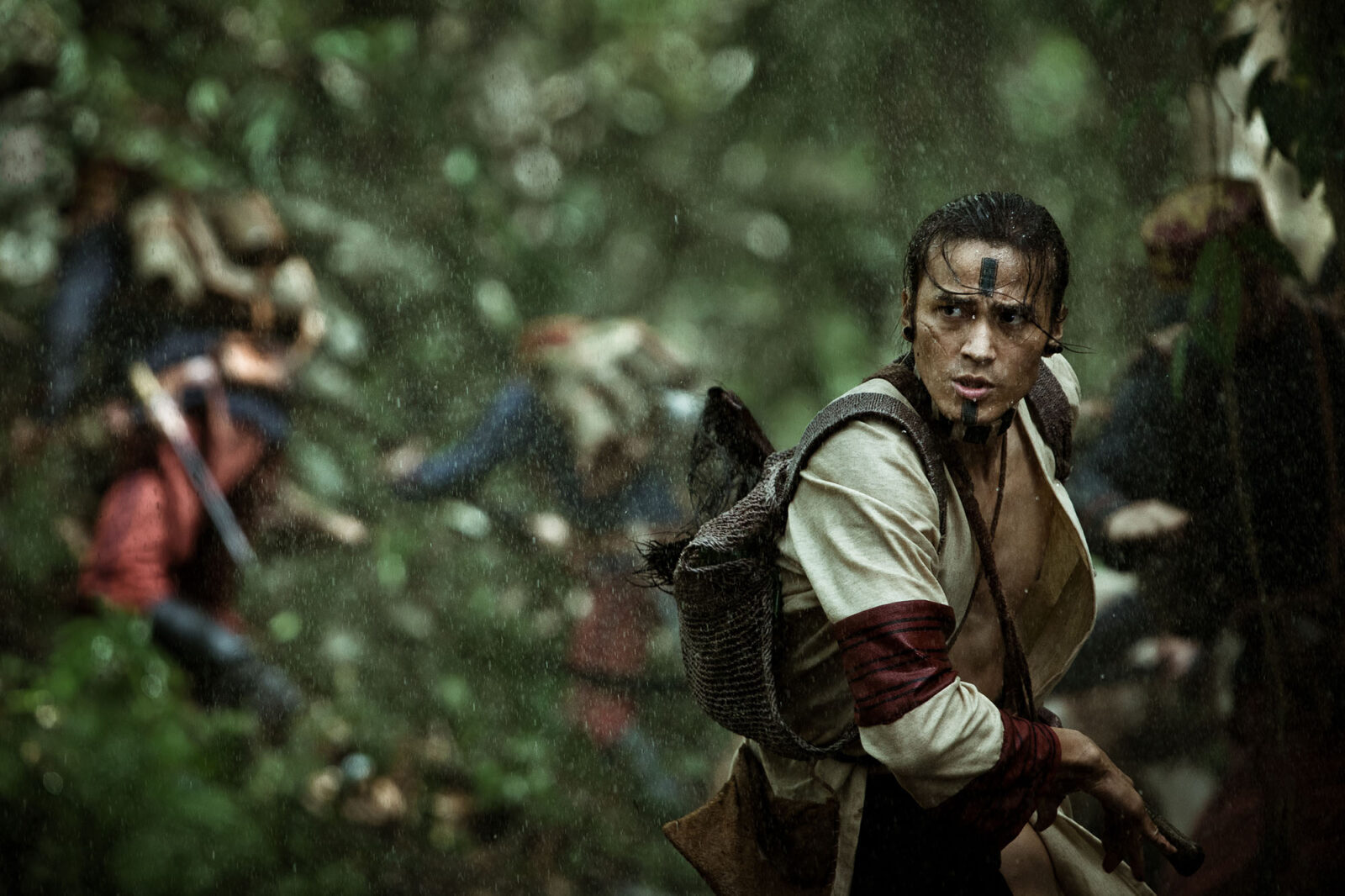Hermenn Regnbogans: Seediq Bale (賽德克·巴萊 Warriors Of Rainbow: Seediq Bale)

Titill: Hermenn Regnbogans: Seediq Bale (賽德克·巴萊)
Tími: 20. mars 2019 18:00 – 22:00
Staður: Bíó Paradís
2012 / 150mín
Leikstjóri: Wei Te-Sheng
Tungumál: Seediq, tævanska, japanska
Enskur Texti
Frumsýning á Íslandi
Fordrykkur fyrir sýningu
Wei Te-Sheng, leikstjóri og handritshöfundur, situr fyrir svörum að mynd lokinni.
Stutt samantekt
Fyrir um áttatíu árum síðan i fjöllum Tævan áttust tveir ættbálkar við í trúabragðastríði.
Annar tilbað regnbogann, hinn sólina. Hvorugur ættbálkurinn gerði sér grein fyrir því að þeir tilbáðu báðar sama himininn.
Í „Hermönnum Regnbogans“, epískri stórmynd frá leikstjóranum Wei Te-Sheng, rifjar hann upp ótrúlega sögulega 20.aldar atburði sem eru jafnvel huldir heimafólki í Tævan. Milli áranna 1895 og 1945 var eyríkið japönsk nýlenda sem var að meirihluta til búsett kínverskum innflytjendum af Han-ætt en einnig frumbyggjaþjóðum sem fyrst námu þetta fjöllótta land. Árið 1930 settist Mouna Rudo, leiðtogi eins Seediq-ættbálksins, að með sínu fólki á og umhverfis Chilai-fjall þar sem hann myndaði bandalag með öðrum Seediq-ættbálkum um að undirbúa uppreisn gegn japönsku nýlenduherrunum. Uppreisnin hófst á íþróttaviðburði þar sem ættbálkarnir höfðu hópast saman og var ætlað að ráðast gegn og drepa japanska embættismenn áður en uppreisnin bærist út til lögreglustöðva nágrennisins og annara stjórnsetra í héraðinu. Uppreisnin kom Japönunum algjörlega í opna skjöldu og heppnaðist að nær öllu leyti. En fljótt sendu Japanirnir heri sína inn til að berja á uppreisnarliðum og beittu þar bæði flugher sínum sem og eiturgas-árásum.
Mouna Rudo vissi frá upphafi að hinir tiltölulega fámennu heraflar Seediq-ættbálkanna höfðu ekki roð við hinn öfluga japanska her. Hann og bandamenn hans leituðu þó stuðnings í trúnni og goðsögnunum sem fylgt höfðu ættbálkunum frá örófi alda. Ungir karlmenn meðal ættbálkanna gengust undir innvígslu-athöfn til að vera teknir inn í tölu fullorðinna og öðluðust þar með réttinn til að húðflúra andlit sín. Þannig urðu þeir hetjur ættbálkanna eða „Seediq Bale“ líkt og það nefnist á þeirra tungumáli. Þeir trúðu því að þegar að þeirra tími kæmi myndu forfeður þeirra leiða anda „Seediq Bale“ yfir regnbogabrú og til móts við þá upp á fjallstoppi. Hvernig svo sem þeim myndi reiða eftir uppreisnina gegn Japönum myndu þeir þramma saman í sigurmars yfir regnbogabrúna. Hetjuskapur og hugrekki Seediq-stríðs-manna og kvenna kom jafnvel Japönunum á óvart og ávann þeim varanlega virðingu.
Verðlaun
2011 Gullni Fákurinn (Óskar kínversks málsvæðis)
Besta Myndin
Besti leikari í aukahlutverki – Bokeh Kosang
Besta kvikmyndatónlist
Bestu hljóðbrellur
Title: Warriors Of Rainbow: Seediq Bale (賽德克·巴萊)
Time: 20 March 2019 18:00-22:00
Venue: Bíó Paradís
2012 / 150 min
Director: Wei Te-Sheng
Language: Seediq, Taiwanese, Japanese
Subtitles: English
Iceland premiere
PreScreening drinks
Q&A with writer-director Wei Te-Sheng
Synopsis
Some eighty years ago, in the mountains of Taiwan,
two races clashed in defense of their faiths.
One race believed in rainbows, the other believed in the sun.
Neither side realized that they both believed in the same sky.
Wei Te-Sheng’s epic film Warriors of the Rainbow: Seediq Bale reclaims an extraordinary episode from 20th-century history which is little-known even in Taiwan. Between 1895 and 1945, the island was a Japanese colony inhabited not only by the majority (Han Chinese immigrants) but also by the remnants of the aboriginal tribes who first settled the mountainous land. In 1930 Mouna Rudo, the leader of one of the Seediq tribes settled on and around Mount Chilai, forged a coalition with other Seediq tribal leaders and plotted a rebellion against their Japanese colonial masters. It was to begin at a sports day meeting where the assembled tribesmen were to attack and kill the Japanese officials and would then broaden to sieges on police stations and local government offices in the region. The initial uprising took the Japanese by surprise and was almost entirely successful. But the Japanese soon sent in their army to crush the rebellion, using aircraft and poison gas.
Mouna Rudo knew from the start that the relatively small force of Seediq tribesmen stood no chance of defeating the might of Japan. But he and his allies were sustained by the beliefs and myths which had nourished their tribes since time immemorial. Young males in the tribes had to undergo a rite de passage to become adult men, which gave them the right to have their faces tattooed. In the tribal language, they became Seediq Bale – heroes of the tribe. Their belief was that their ancestors would lead the spirits of the Seediq Bale across a rainbow bridge to the summit of the mountain when their time came. And so, whatever the result of their uprising against Japan, they would march in victory across the rainbow bridge… The heroism and fortitude of the Seediq warriors and their womenfolk shocked even the Japanese and won them enduring respect.
Awards
2011 Golden Horse Awards (Chinese-language Oscars):
Best Feature Film
Best Supporting Actor – Bokeh Kosang
Best Original Film Score
Best Sound Effects
Q&A panel discussion: Wei Te-Sheng, Birna Hafstein, Björn Þór Vilhjálmsson, Fridrik Thor Fridriksson
Wei Te-Sheng:
founder of ARS Film, Taiwanese writer, director, producer and voice actor.
Birna Hafstein:
actress, producer, leader of the actors association in Iceland, chairmen of the board of Stockfish, president of performing arts in Iceland.
Björn Þór Vilhjálmsson:
assistant professor of Film Studies and Comparative Literature at the University of Iceland. He holds a phd in Critical Literary and Cinema Studies from UW Madison.
Fridrik Thor Fridriksson:
director, started his film making carrier with a series of experimental films and documentaries in the early 1980s. In 1987, he founded The Icelandic Film Corporation, which has become Iceland’s most important production company, producing Fridrikssons films as well as working with other Icelandic directors and producers. Through Fridriksson’s international reputation the company has built a network of internationally well-established co-production partner companies, including Lars von Triers Zentropa and most recently, Francis Ford Coppola’s American Zoetrope. As a director, Fridriksson gained international recognition and critical acclaim with his second feature _Children of Nature (1991)_ which was nominated for an Oscar as Best Foreign Language Film.
 No products in the basket.
No products in the basket.